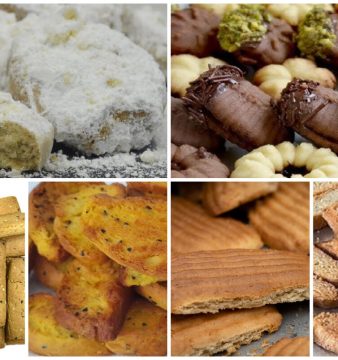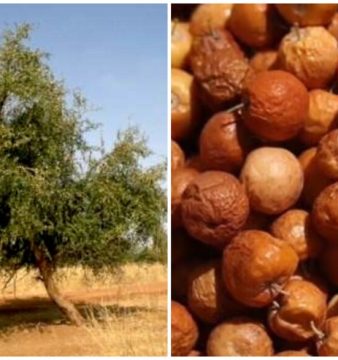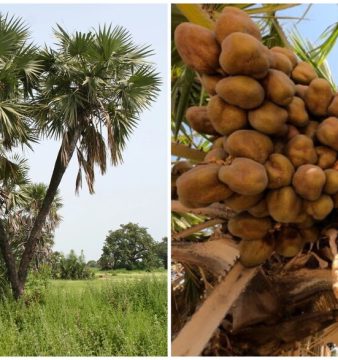The Vegan Life — As a South Sudanese Vegan

500 Words Magazine gets in conversation with South Sudanese-British vegan blogger, Bachay Akolawin, of Make, Eat, Repeat. Akolawin is a relatively new vegan. She became vegan about two and half years ago, which then motivated her to create the vegan blog, Make, Eat, Repeat, showcasing her new lifestyle as a vegan and sharing vegan recipes, reviews and lifestyle tips.
So what is veganism? As defined by The Vegan Society, ‘A philosophy and way of living which seeks to exclude—as far as is possible and practicable—all forms of exploitation of, and cruelty to, animals for food, clothing or any other purpose; and by extension, promotes the development and use of animal-free alternatives for the benefit of humans, animals and the environment. In dietary terms, it denotes the practice of dispensing with all products derived wholly or partly from animals.’
Veganism was born out of vegetarianism. Vegans avoid all animal-derived foods such as meat, chicken, fish, eggs, dairy and even honey. They also exclude animal by-products like rennet used in cheese making, gelatine in desserts and certain food additives called E-numbers including the red food dye cochineal (E120). Even certain vegetarian foods and meat substitutes are off the menu because they contain egg and sometimes dairy.
Akolawin speaks about her journey to veganism and how it inspired her to create the vegan blog, Make, Eat, Repeat.
What inspired you to create your blog, Make, Eat, Repeat? How long have you been running it?
I love to share my experiences and when people found out that I became a vegan they asked me for tips and advice. So I thought that it would be great to create a blog to showcase my experiences as a vegan of South Sudanese descent in London. I have been running the website makeeatrepeat.co.uk since August 2017.
What are some of the challenges of running a vegan blog?
One of the challenges which I encounter include trying to fit all my ideas into the blog. A blog article can take days and sometimes weeks of research to perfect. Therefore, I try my best to post articles which are to the point and provide some value for my readers. I tend to post recipes, reviews, my experiences in London and during travel.
Growing up in West London, I was lucky to be able to try a wide range of world cuisines such as Indian, Asian, Chinese, Italian and Mediterranean food. I also get bored easily and so, I like to try a variety of different foods such as mixed fruit breakfast bowls, rice bowls, tofu dishes, curries, sandwiches and pasta. I create recipes which are full of flavour and easy to make.
Why and when did you decide to become vegan?
In April 2016, I became vegan overnight. I had always eaten meat on a daily basis but my real love was cheese and butter. In February 2016, I was diagnosed with a Vitamin D deficiency and high cholesterol. I was advised by my doctor to reduce my dairy consumption as it was the obvious culprit. I replaced cheese and eggs with lentils or beans. After two months, my cholesterol was back into a healthy range. By this point, I had stopped craving meat and after a month of watching vegan YouTube videos, I became vegan overnight — as I couldn’t justify my need to eat meat anymore. I was healthier as a vegan and cared about animal cruelty.
What were the first days or months of veganism like?
It was strange at first as I didn’t know what to do. And then I found hashtags. Instagram is the best for food and I used hashtags such as #vegansofig #blackvegan #africavegan #veganrecipes etc to share my views. Twitter was also very friendly and vegans eagerly welcome newbies. The #veganhour chat at 7 pm GMT/ BST every Tuesday gave me more information and helped me make vegan friends.
How do you explain your new lifestyle to your loved ones including family and friends?
I tell them that after changing my diet for health reasons I just stopped craving meat and after research realised that I don’t need meat any more. I still eat the same food I used to before but without meat; and now I am getting more nutrients than I did before I turned vegan. I still eat vegan biscuits, sandwiches, ice cream etc.
Tell us about your diet. What does it consist of?
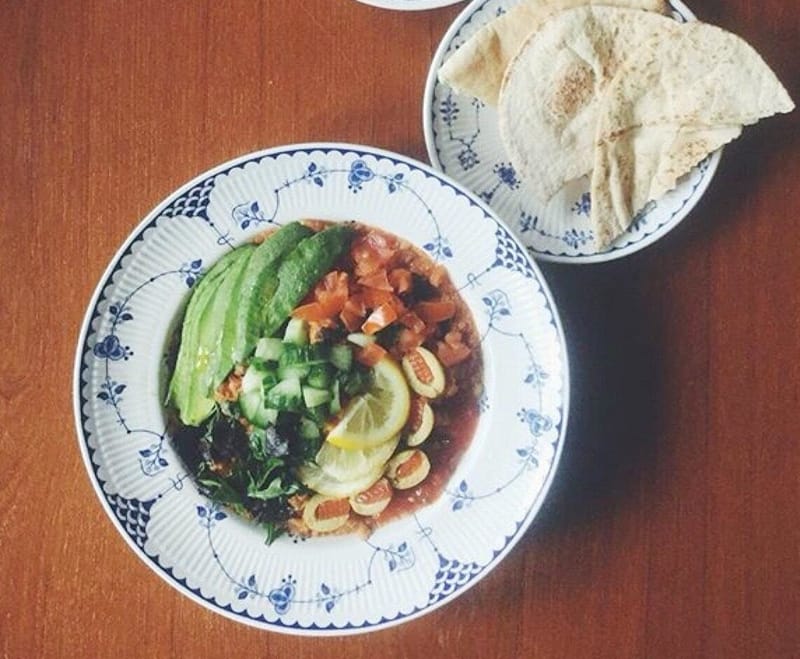
Ful Medames with chopped tomatoes, mixed leaf salad, cucumbers, 1/4 of an avocado, lemon and olives served with toasted pita bread
Breakfast
- Toast with sliced bananas or sliced strawberries or vegan butter
- Vegan cereal
- Porridge made with water or plant milk (usually almond or oat milk), cinnamon and mixed berries. Topped with more mixed berries, nuts and a sliced banana.
Late breakfast or brunch
- Ful Medames
- Addas
- Mashed avocado on toast with a squeeze of lime and some chili
- Scrambled tofu
Lunch
- Ta’miya/falafel with grilled aubergine, humus, olives, green lentil salad, tomato and cucumber
- Vegan cheese toastie with salad
- Vegan chicken and sweetcorn sandwich
Dinner
- Lentil Bolognese with pasta (Lentils cooked in tomato sauce, garlic and Italian herbs)
- Lentil Dhal (Addas cooked in tomato sauce with chilli and ginger)
- Molokhia and rice/Kisra/Injera
- Shorba and rice
- Buddha bowl – beans, lentils, sweet potatoes and salad with Peri Peri sauce or peanut butter sauce (peanut butter mixed with water)
Dessert – Fruit or dark chocolate
Snacks, which are accidentally vegan food:
- Oreo cookies
- Salt and vinegar crisps
- Tortilla chips
- Doughnuts
- Vegan pizza
- Ben & Jerry’s vegan ice-cream
Do you find that the Sudanese/South Sudanese community, especially the one you’re surrounded with, is accepting or understanding of your life choice?
They accept my choice but some people think it’s just a phase. They always ask me if:
1. I am still vegan?
2. Don’t I miss chicken?
3. If I still eat cheese and fish?
After I explain that I don’t eat eggs, fish, meat, honey and dairy products, they normally get confused. When I explain that I replace these foods with fruits and vegetables or vegan alternatives, then they understand. For example, at a restaurant, instead of ordering a chicken wrap, I order vegan chicken wrap or humus and falafel wrap.
Do you try to motivate other people to become vegan as well, or do you believe it’s not for everyone?
No, I just tell people that I understand that most people will not become vegan, as everyone has to find their own connection to veganism. I personally found veganism accidentally due to ill-health. So if I speak to people who are also suffering from health issues, I advise them to increase plant-based food into their diet even if it’s just once or twice a week to begin with. This could range from eating leafy greens and lentils as part of their lunch or adding antioxidant rich fruits such as blueberries or mixed berries into their breakfast bowl.
Everyone makes mistakes when following a vegan diet as there will be times when you mistakenly eat a product with milk, eggs or fish. This could be a biscuit, a sandwich or drink. This does not make you any less of a vegan or vegetarian as veganism is a process.
What are some of the challenges of being a vegan especially in the Sudanese/South Sudanese community?
Most people don’t know what veganism is and still get confused with what foods vegans can eat. Also, many people think it’s unnatural and a western concept or they ask what I will cook for my husband if I won’t cook meat? But in reality, there are men who eat a lot of vegan food, especially in London, where vegan fried chicken and kebab are quite popular.
As a vegan, what do you enjoy when it comes to the Sudanese/South Sudanese cuisine? Have you made vegan versions of Sudanese/South Sudanese food?
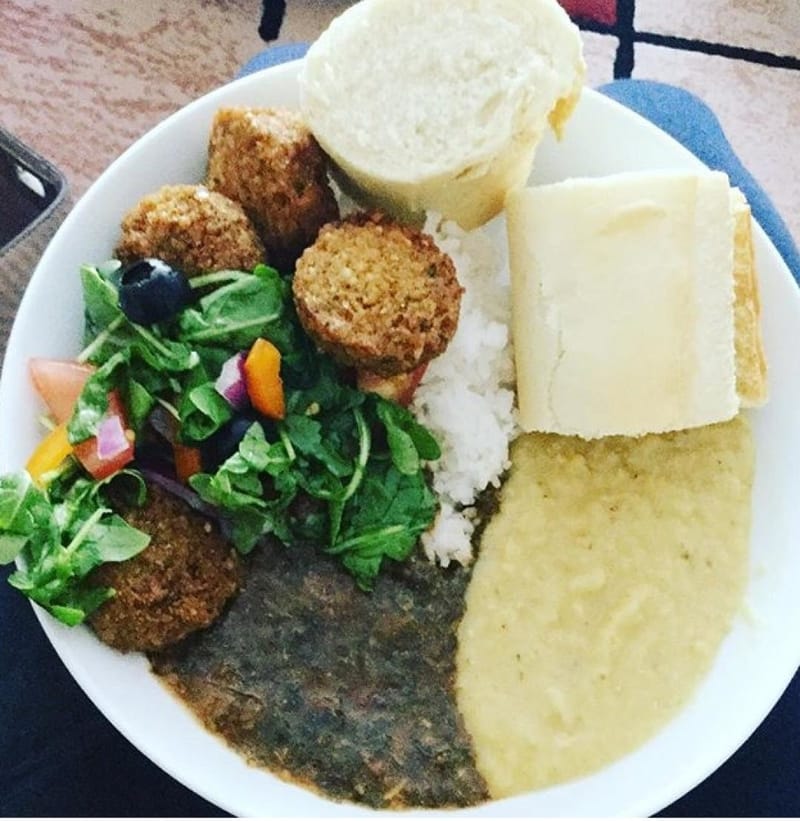
Addas, molokhia, salad, ta’miya, rice, sliced baguette
I use vegetable stock to replace chicken stock and vegetable or vegan alternatives to replace meat. Meals such as ta’miya, legemat and salatat aswad is normally vegan aka accidentally vegan. There are also vegan versions of Sudanese dishes which are easy to create but the majority of Sudanese meals are quite time-consuming. This deters people from trying to adapt traditional recipes into vegan recipes e.g. shorba and molokhia.
Any recipes of vegan/vegetarian versions of Sudanese/South Sudanese food you can share with us?
Sugar cookies – recipe on Make, Eat, Repeat
Ful Medames – recipe on Make, Eat, Repeat
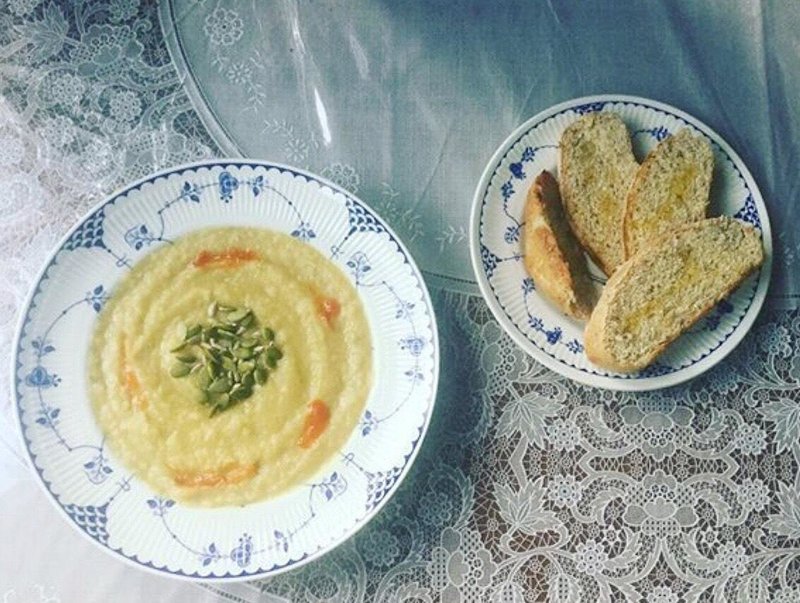
Addas garnished with pumpkin seeds and Caribbean style hot pepper sauce, served with toasted bread lightly drizzled with olive oil
Addas
- 2 onions, chopped
- 3 cups of red lentils
- 1 vegetable stock cube
- 6 cups of water
- Garlic cloves, chopped
- 1 tsp cumin
- ½ tsp coriander
- Salt to taste (1 tsp)
Fry the onions until well-cooked. Turn up the heat and add the lentils, stock cube, coriander, cumin and water and bring it to a boil. Once water starts to boil, lower the heat and simmer for 30 mins. Take it off the heat and blend (optional) with an electric blender, potato masher or any traditional tool. Add garlic and water if necessary and bring to a boil. Turn the heat back to low and cook until you get the desired consistency (10-20 mins). Add salt and serve.
How would you suggest for people to celebrate World Vegan Day, whether vegan, vegetarian or carnivores?
- Legemat (Sudanese doughnuts) can be vegan if made without eggs and milk
- Salata aswad – tomato based ingredients, or coconut or soya yogurt based ingredients
- Shari’ya – made with water or plant milk
- Ta’miya – falafel is also readily available in most supermarkets
- Bread – is mostly vegan unless it contains milk or cheese
- Amorino gelato rose. Left: Strawberry, mango, melon and passion fruit sorbet flavours. Right: Mango, passion fruit, melon and lime basil sorbet flavours
- Starbucks vegan raspberry chocolate cake and Teavana peach tea
- Try a dairy free fruit smoothie by blending your favourite fruits with some water in a blender
- Snacks – bliss balls
- Fresh Fruit
- A handful of pistachio or mixed nuts
- Lunch – falafel and humus salad or wrap
- Vegan sandwiches
- Dinner – swap lamb or beef with red or green lentils to make lentil Bolognese served with your favourite pasta
- Cook soups and stews without meat
For more on Akolawin’s vegan life, visit her website, Make, Eat, Repeat or follow her on Instagram.



